
Taiga, generally referred to in North America as a boreal forest or snow forest, is a biome characterized by coniferous forests consisting mostly of pines, spruces, and larches.
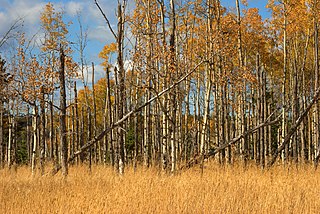
Aspen parkland refers to a very large area of transitional biome between prairie and boreal forest in two sections, namely the Peace River Country of northwestern Alberta crossing the border into British Columbia, and a much larger area stretching from central Alberta, all across central Saskatchewan to south central Manitoba and continuing into small parts of the US states of Minnesota and North Dakota. Aspen parkland consists of groves of aspen, poplar and spruce, interspersed with areas of prairie grasslands, also intersected by large stream and river valleys lined with aspen-spruce forests and dense shrubbery. This is the largest boreal-grassland transition zone in the world and is a zone of constant competition and tension as prairie and woodlands struggle to overtake each other within the parkland.

The grey dagger is a moth of the family Noctuidae.

Populus tremuloides is a deciduous tree native to cooler areas of North America, one of several species referred to by the common name aspen. It is commonly called quaking aspen, trembling aspen, American aspen, mountain or golden aspen, trembling poplar, white poplar, and popple, as well as others. The trees have tall trunks, up to 25 meters tall, with smooth pale bark, scarred with black. The glossy green leaves, dull beneath, become golden to yellow, rarely red, in autumn. The species often propagates through its roots to form large clonal groves originating from a shared root system. These roots are not rhizomes, as new growth develops from adventitious buds on the parent root system.
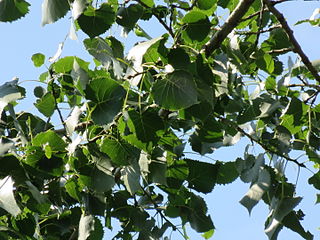
Populus deltoides, the eastern cottonwood or necklace poplar, is a cottonwood poplar native to North America, growing throughout the eastern, central, and southwestern United States as well as the southern Canadian prairies, the southernmost part of eastern Canada, and northeastern Mexico.

The New England-Acadian forests are a temperate broadleaf and mixed forest ecoregion in North America that includes a variety of habitats on the hills, mountains and plateaus of New England and New York State in the Northeastern United States, and Quebec and the Maritime Provinces of Eastern Canada.

Populus balsamifera, commonly called balsam poplar, bam, bamtree, eastern balsam-poplar, hackmatack, tacamahac poplar, tacamahaca, is a tree species in the balsam poplar species group in the poplar genus, Populus. The genus name Populus is from the Latin for poplar, and the specific epithet balsamifera from Latin for "balsam-bearing".
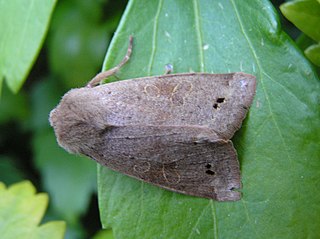
Perigrapha munda, the twin-spotted Quaker, is a species of moth of the family Noctuidae. The wings are gray, with two closely approximate and very conspicuous dark spots on the disc of the fore wings. a small dark apical mark at the costal edge and a discal spot on the fuscous hindwings. It is found in Palearctic realm.

Nymphalis vaualbum or N. l-album, the Compton tortoiseshell, or false comma, is a species of butterfly in the family Nymphalidae.

Enargia paleacea, the angle-striped sallow, is a moth of the family Noctuidae. It is found in the Palearctic realm from Ireland to Siberia East to Japan.

Populus grandidentata, commonly called large-tooth aspen, big-tooth aspen, American aspen, Canadian poplar, or white poplar, is a deciduous tree native to eastern North America.

Enargia is a genus of moths of the family Noctuidae.
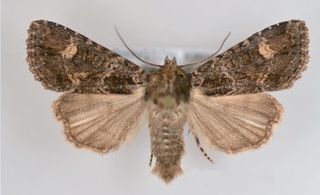
Aseptis binotata, the rusty shoulder knot moth, is a moth of the family Noctuidae. The species was first described by Francis Walker in 1865. It is found widespread in western North America, west of south-central Alberta, Wyoming, and Nebraska. Along the Pacific Coast it occurs from northern Mexico to south-central British Columbia. It can be found from sea level to altitudes over 2000 meters in a variety of habitats from dense forest to shrub desert.
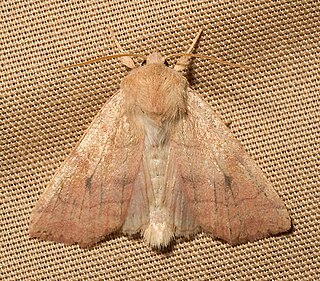
The lesser eyed sallow is a moth of the family Noctuidae. It is found from Alaska and New Brunswick to Ontario, south to Connecticut in eastern North America. In western North America it is found from Saskatchewan and Alberta, south to Utah and California.

Populus heterophylla, also known as downy poplar, swamp poplar and swamp cottonwood, is a large deciduous poplar belonging to the Populus genus of the family Salicaceae. This species can grow on sites that have too much water for other native poplars. On the IUCN Red List this species is listed as "least concern".

Smerinthus caecus, the northern eyed hawkmoth, is a moth of the family Sphingidae. The species was first described by Édouard Ménétries in 1857.
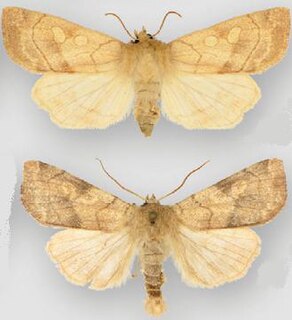
The pale enargia or aspen twoleaf tier is a moth of the family Noctuidae. It has a boreal-transcontinental distribution, occurring across the Canadian boreal plain and then southward through the western cordillera at higher elevations, where it is presumably limited by the availability of trembling aspen and possibly other poplars. Records range from northernmost British Columbia and south-western Northwest Territories east to New Brunswick. It has also been reported from Nova Scotia, Ohio and New York. In the western United States it is known from western Montana, Idaho, Washington, Oregon, Nevada, Utah, Wyoming, western Colorado, New Mexico, and Arizona. There are no records from the Rocky Mountain front ranges of Colorado, where it would be expected to be widespread if there is a continuous distribution southward into New Mexico and Arizona. The populations from west of the Rocky Mountains south to New Mexico and Arizona may represent a distinct species.
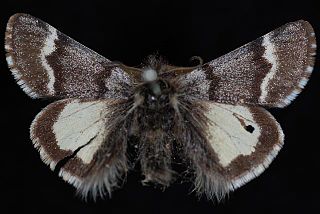
Leucobrephos brephoides, the scarce infant moth, is a moth of the family Geometridae. The species was first described by Francis Walker in 1857. It is found in North America from Yukon to Labrador and south to New York and southern Alberta and British Columbia. The habitat consists of open mixed wood forests of the boreal and mountain region.
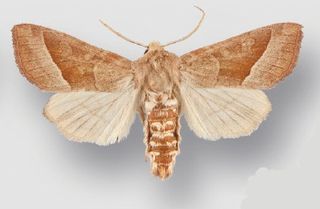
Hydraecia obliqua is a moth in the family Noctuidae first described by Leon F. Harvey in 1876. It is found in western North America, east to the Sierra Nevada in California and the crest of the Cascade Range in Oregon and Washington. It occurs continuously on the coast north to south-western British Columbia, with a disjunct northern population at Terrace, British Columbia. The habitat consists of the riparian zone along creeks and rivers of coastal rainforests, as well as oak savanna, mixed hardwood forests and valley grasslands.

Hydraecia medialis is a moth in the family Noctuidae. It is found in western North America. East of the Cascades, it occurs as far north as the Cariboo region in south-central British Columbia. The range extends across the Rocky Mountains in Montana and then spreads north and south on the Great Plains to reach Alberta, the western Dakotas and northern New Mexico. The habitat consists of open ponderosa pine forests, drier sagebrush steppe and juniper woodlands.




















